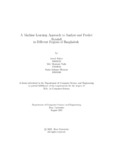A machine learning approach to analyze and predict rainfall in different regions of Bangladesh
Abstract
Rainfall has always been important in context of Bangladesh as almost 43% of the
population depends on agriculture for their livelihood. Global warming has been
taking a toll on environment and rainfall patterns have been changing around the
world. Almost half the population depends on rainfall for irrigating their lands and
grow crops. If rainfall can be predicted precisely then people involved with agricultural sector will be benefited. In this research, we analyzed the rainfall statistics
on the basis of Bangladesh Meteorological Department’s data of rainfall of last 66
years. With Mann-Kendall Trend Test with 5% level of significance we tested the
trend of 6 divisional stations of Bangladesh. Later we utilized three regression models to predict rainfall on basis of data from 1948 to 2014. We have also implemented
those 3 regression models on 6 regional station data to understand if there is any
change in accuracy. Trend tests showed no significant change in rainfall patterns in
last 30 years. We also broke down the data to understand the hydrological regions
of Bangladesh and the rainfall by stations.

